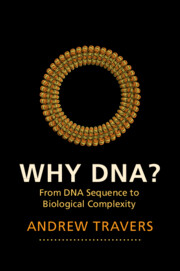Book contents
- Why DNA?
- Frontispiece
- Why DNA?
- Copyright page
- Contents
- Preface
- Acknowledgements
- 1 The Perennial Question
- 2 The Nature of Biological Information
- 3 DNA
- 4 The Evolution of Biological Complexity
- 5 Cooperating Genomes
- 6 DNA, Information and Complexity
- 7 Origins of Complexity
- 8 The Complexity of Societies
- 9 Why DNA
- General Reading and Bibliography
- Index
4 - The Evolution of Biological Complexity
Published online by Cambridge University Press: 05 May 2022
- Why DNA?
- Frontispiece
- Why DNA?
- Copyright page
- Contents
- Preface
- Acknowledgements
- 1 The Perennial Question
- 2 The Nature of Biological Information
- 3 DNA
- 4 The Evolution of Biological Complexity
- 5 Cooperating Genomes
- 6 DNA, Information and Complexity
- 7 Origins of Complexity
- 8 The Complexity of Societies
- 9 Why DNA
- General Reading and Bibliography
- Index
Summary
Many discussions of the biological world use the terms complex or complexity. But what is the real sense of these words? Conceptually the usage of complexity is slippery and is often used synonymously with diversity. In any system consisting of many components, its diversity, in the sense used in this book, is a measure of the number of different types of entity present and does not, on its own, necessarily imply any interactions between them. The components of a system could be entirely independent. However, complexity is a different beast and is admirably exemplified by biological systems. In a complex system the different components interact with, and influence the behaviour of, other components of the system. In this sense the complexity of a system is a measure of a functioning whole.
- Type
- Chapter
- Information
- Why DNA?From DNA Sequence to Biological Complexity, pp. 93 - 127Publisher: Cambridge University PressPrint publication year: 2022

